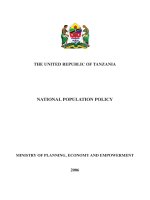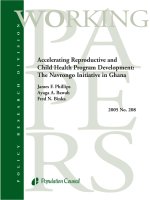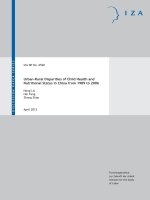Issues of child health and development at ages 1-2 and 3-4 years ppt
Bạn đang xem bản rút gọn của tài liệu. Xem và tải ngay bản đầy đủ của tài liệu tại đây (140.53 KB, 5 trang )
The Growing Up in Scotland study (GUS) is an important longitudinal research project aimed at tracking the lives of a cohort
of Scottish children from the early years, through childhood and beyond. Its principal aim is to provide information to support
policy-making, but it is also intended to be a broader resource that can be drawn on by academics, voluntary sector
organisations and other interested parties. Focusing initially on a cohort of 5,217 children aged 0-1 years old and a cohort
of 2,859 children aged 2-3 years old, the first wave of fieldwork began in April 2005. This document is one of a series that
summarise key findings from the second sweep of the survey which was launched in April 2006. At the second sweep,
interviews were successfully completed with 4,512 respondents from the birth cohort and 2,500 from the child cohort.
Methods
GUS is based on a cohort or longitudinal design involving the recruitment of a 'panel' of children (and their families) who will
be revisited on a number of occasions over an extended period of time. Members of the panel were identified in the first
instance from Child Benefit records. For the second year of the study, interviews were sought with the person who had
responded at sweep 1. In virtually all cases (98%), this proved to be the child’s mother. As well as the main interview, at
sweep 2, interviews were also undertaken with the resident partner of the main respondent, where applicable. A total of
2,975 partner’s interviews were successfully completed in the birth cohort and 1,541 in the child cohort. As well as
information on child health and development, the main interview also collected data on food and nutrition, childcare,
parenting and local neighbourhood.
This report looks at parental perceptions of their child’s health and development and their use of health-related services. It
examines differences in child health and illness by key family characteristics and compares general parental assessments of their
child’s development against those attained on formal child development scales. Data from anthropometric measurements are
also explored.
Main Findings
■ The vast majority of respondents said their child’s health was ‘good’ or ‘very good’.
■ Respondents with female offspring, higher levels of household income or who were part of couple families tended to rate the
general health of their children mor
e highly.
■ In total, 11% and 16% of the birth and child cohorts respectively were reported as having a long-standing illness or disability.
In both cohorts, long-standing illness was mor
e common in boys than girls. Less than 10% of children in the child cohort, and
less than 5% in the birth cohort were reported to have a long-standing illness at both sweeps.
Issues of child health and development
at ages 1-2 and 3-4 years
Growing Up in Scotland – Sweep 2 – Topic Research Findings
Research Findings
No.3/2008
Parental perceptions of general
health
The data in Table 1 show that most respondents at both
sweeps thought that the health of their child was at least
good. Perceived good health appeared to reduce between
sweeps in both cohorts demonstrated by a decrease in the
proportion of parents rating their child’s health as very good
and a slight increase in the proportion who said it was fair to
very bad.
■ Data from the two sweeps suggest that accidents amongst young children are most common between the ages of 2-3 years.
At sweep 2, par
ents of boys continued to be mor
e likely to report their child had had an accident than were parents of girls.
■ Nine out of ten parents in both cohorts had been in contact with a health professional in relation to their child’s health at least
once in the six months prior to their interview, and ar
ound two-fifths had done so on two or more occasions.
■ GPs continued to be the main source of information or advice on child health. However, some key differences were identified
across the sample in the extent to which this, and other
, sources of information were likely to be used. For example, those in
higher household income groups were more likely to say that they had sought help from books, leaflets, the internet (both
cohorts) and the GP (birth cohort only) compared with those in lower household income groups.
■ The majority of children in the older cohort were of normal weight. However, 23% were overweight (including obese). Girls
were mor
e likely than boys to be overweight (19% compared with 16% of boys) and more likely to be obese (7% compared
with 5% of boys).
■ In both cohorts, boys were shown to perform less well than girls on the child development scales. Some stark differences in
levels of communication skills and problematic behaviour wer
e also evident by household income and maternal education.
At sweep 2, respondents with female offspring, those with
higher levels of household income or who were part of
couple families tended to rate the general health of their
children more highly, as was the case in sweep 1. For
example, at sweep 2, in the child cohort 57% of lone
parents compared with 69% of couple family parents
perceived that their child’s health was very good.
Long-standing illness and
disability
Parents were asked whether their child had any long-standing
illness (lsi) or disability – the definition of these illnesses or
disabilities being any ailment that had troubled or was likely
to affect the child over a period of time. In total, 11% and
16% of the birth and child cohorts respectively were
reported as having such a health problem in sweep 2,
representing a slight decrease from sweep 1. Of those who
were reported as having at least one long-standing illness,
around one-fifth in both cohorts was said to be limited in their
activity as a result (about 2% of all children in the birth cohort
and 3% of all children in the child cohort).
Respondents from households with lower levels of income
were more likely to report that their children had experienced
a lsi or disability at both sweeps 1 and 2 compared with
those living in households with higher levels of income. For
example, in the child cohort at sweep 2, 21% of parents in
the lowest income group said their child had a long-standing
illness or disability compared with 14% in the highest income
group.
2
Table 1 Perceptions of child’s general health by
cohort and sweep
Cohort (%)
Birth cohort Child cohort
Child health Sweep 1 Sweep 2 Sweep 1 Sweep 2
Very good 74.6 66.9 72.9 66.4
Good 19.6 25.6 21.6 26.1
Fair to very bad 5.8 7.5 5.5 7.5
Bases
Weighted 4511 4510 2500 2499
Unweighted 4511 4510 2500 2499
As maybe expected at this stage, parents of overweight and
normal weight children were both likely to report their child’s
health as being good or very good (94% and 92%
respectively). However, children who were obese were
slightly more likely to have a long-standing illness than
overweight (not including obese) or normal weight children
(18% of obese children compared with 15% of non-obese
children).
Sources of help, information and
advice on child’s health
As well as being asked about contact with specific health
services, parents were also asked about sources of help,
information and advice they had used in the last year when
they had concerns over the sample child’s health. The list
included formal and informal resources.
Eighty-three percent of respondents in the birth cohort and
76% in the child cohort reported having used at least one
source for information or advice about their child’s health.
The proportions using the various sources are detailed in
Figure 2. The family doctor or GP was the most popular
source of help with the respondent’s parents, NHS 24, health
visitors and other family members or friends with children
also popular.
Figure 2 Percentage of parents using each source for
help, information or advice on sample child’s health by
cohort
3
1
The main child overweight and obesity prevalence estimates in this section have been produced using the International Obesity Taskforce cut-offs. These
cut-offs are based on BMI reference data from six different countries around the world (over 190,000 subjects in total aged 0-25 from UK, Brazil, Hong Kong,
The Netherlands, Singapore, and the United States).
Accidents and injuries requiring
NHS contact
In addition to health problems, respondents were also asked
if the child had experienced one or more accidents or injuries
which had required NHS contact since the sweep 1 interview.
Overall, 23% of parents in the birth cohort and 19% of
parents in the child cohort reported that their child had
experienced such an accident. During the sweep 1 survey,
accidents were more commonly reported in the older cohort
whereas at sweep 2 they were more common in the younger
cohort. This reflects the particular developmental stages of
the children in each cohort at each sweep and suggests that
accidents may peak between the ages of 2 and 3. Bangs on
the head were the most common injury reported, followed by
cuts or grazes, and cuts needing stitches.
Boys in both cohorts were more likely than girls to have an
accident requiring NHS attention (in the birth cohort: 21%
versus 16%), a trend also evidenced in sweep 1 data. In the
birth cohort, children with lone parents, from households of
lower socio-economic status and lower income were more
likely to have had an accident requiring a visit to NHS
facilities. However, these factors did not appear to have the
same influence in the child cohort.
Anthropometric measurements,
overweight and obesity
At sweep 2, height and weight measurements were taken of
children in the child cohort. These measurements were used
to calculate the child’s body mass index (BMI). Using cut-off
points derived from internationally collected data
1
, BMI
values can be used to indicate the proportion of children
who are normal weight, overweight and obese.
As would be expected for this age, mean heights and weight
for boys and girls were almost identical. The mean height
for boys was 102cm and for girls, 101cm. The mean
weights were 17.5kg for boys and 17.0kg for girls.
The majority of children (77%) of both sexes were of ‘normal
weight’ (that is, their BMI fell below the 85% percentile). This
meant that 23% of children were overweight (including
obese). Girls were more likely than boys to be overweight
(19% compared with 16% of boys) and more likely to be
obese (7% compared with 5% of boys).
Family doctor/GP
Your own parents
NHS 24
Your health visitor
Other friends/
family with children
The internet
Books or leaflets
Your partner’s
parents
No concerns
over last year
Parents in the birth cohort were more likely to have used
each source of information than their counterparts in the
child cohort. This reflects not only fewer health problems
observed in the older cohort but also perhaps a growing
confidence among parents in their ability to diagnose and
treat common and trivial illnesses in their children without the
need to seek help or advice from others.
Some differences in use of particular sources were noted.
For example, those in the lowest household income group
were less likely to say that they had sought help from books,
leaflets and the internet compared with those in the highest
income quartile. Also, in the birth cohort 79% in the highest
income group compared with 67% in the lowest income
group reported seeking help from a GP, but this difference
was not observed in the child cohort. Differences were also
noted by level of maternal education; compared to those with
no qualifications, mothers educated to Standard grade,
Higher grade or beyond were more likely to have sought
advice and to have consulted more sources.
Language and behavioural
development
As well as registering their own general concerns of their
child’s development, language and behaviour, respondents
were asked to complete questions which assessed specific
aspects of their child’s communication skills and behaviour.
Questions for parents in the birth cohort form the
Infant/Toddler checklist of the Communication and Symbolic
Behaviour Scales (CSBS) (Wetherby and Prizant, 2001),
whereas parents in the child cohort completed the Strengths
and Difficulties Questionnaire (SDQ) (Goodman, 1997).
In relation to the CSBS, boys were more likely to be of
concern than were girls, particularly in terms of their speech
development – 20% of boys were classed as ‘of concern’ in
relation to their speech compared with 12% of girls. Indeed,
parents of male children were more likely to register their
own concern about their child’s speech and language
development than were parents of female children. Lower
scores on the CSBS scale, suggesting poorer relative
communication skills, were also returned by parents in lower
income households and by those who had no educational
qualifications.
In the child cohort, responses to the SDQ indicated that male
children, and children of respondents in lower income
households or with no educational qualifications had higher
average scores, indicating that they were more likely to
exhibit difficult behaviour, than female children and those
living in higher income households or whose parents had
educational qualifications.
Conclusion
Overall, children of this age are reported as being healthy,
with only a small percentage of parents reporting their
children’s health to be fair to very bad. The persistent
differences in health status across both sweeps according to
household income and family type suggest that we may be
likely to see the gradual emergence of a gradient for these
health related measures according to socio-economic status.
Use of health services in relation to the cohort child was
predominant in both cohorts with the most common contact
being a GP. GPs were also the most frequently cited source
of advice about the child’s health. This suggests that primary
care remains a very important resource for parents and their
children.
In relation to child development, quite clear differences were
evident in both cohorts by the child’s gender and by certain
measures of advantage and disadvantage. Parental level of
education is very important and is emerging as a crucial site
for intervention if adverse outcomes for parents and children
are to be avoided or ameliorated.
References
Goodman, R. (1997) “The Strengths and Difficulties
Questionnaire: A Research Note”,
Journal of Child
Psychology and Psychiatry
, 38, 581-586.
Wetherby, A.M. and Prizant, B.M. (2001), Communication
and Symbolic Behaviour Scales - Infant/Toddler Checklist,
Baltimore: Paul H. Brookes Publishing Co.
4
5
If you wish further copies of this Research Findings or have any queries about the GUS project, please contact:
Education Information and Analytical Services
Scottish Government
Victoria Quay
Edinburgh, EH6 6QQ
Dissemination Officer on 0131-244 0894;
by e-mail on
or visit our website www.scotland.gov.uk/insight
Research Findings, Reports and information about social research in the Scottish Government may be viewed on the
Internet at:
/>The site carries up-to-date information about social and policy research commissioned and published on behalf of the
Scottish Executive. Subjects covered include transport, housing, social inclusion, rural affairs, children and young people,
education, social work, community care, local government, civil justice, crime and criminal justice, regeneration, planning
and women’s issues. The site also allows access to information about the Scottish Household Survey.
RR Donnelley B54908 02-08









